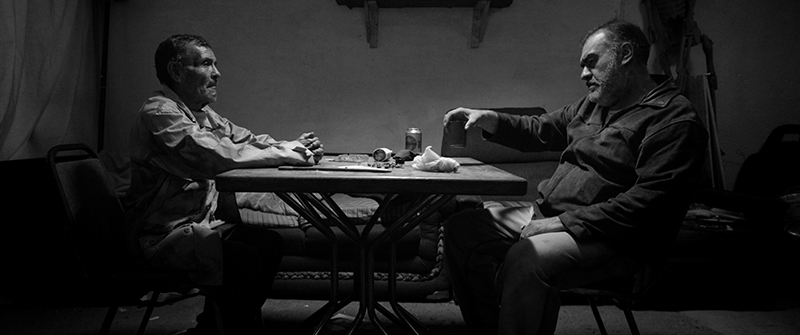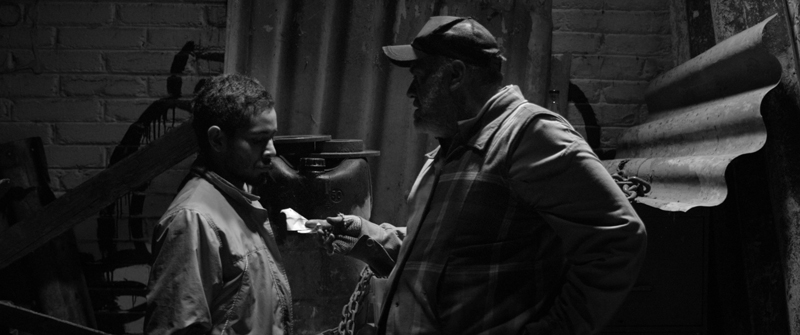
Talking Poetry, Surrealism and Collecting Rubbish with Mexican Film-Maker Michel Lipkes
09 February, 2018In his latest film Extraño pero verdadura (Strange But True, 2017), Michel Lipkes tells the story of two young lovers, Jonathan and Yesi, who work on a rubbish truck, and their fellow workmates, Maestro Limpio (Master Clean) and a mute older man nick-named Momia. One night they discover a corpse in the rubbish and what follows is less film noir than an imagistic comment on machismo and narco-brutality in Mexico today.
Lipkes was born in Mexico City in 1978 and studied film at the city’s Centro de Capacitación Cinematográfica. He made his feature film bow with Malaventura (Bad Luck) in 2011. That film, as with Extraño pero verdadura, worked with the elusive ability of images, to communicate without words, following Robert Bresson’s belief that cinema has more in common with music and poetry than writing or theatre. Lipkes loves silent movies, and likes to get to know his characters without the insistent demand to narrate. “Just putting five images side-by-side is enough to create something intimate”, he says, describing an intimacy that is not possible in theatre. He favours the slow cross-dissolve instead of a sharp break in his transitions.
Yet Extraño pero verdadura is not a mystical film, it deals with the brutal reality of Mexico today, where violent trauma has deformed personalities into monsters, or as with the case of Momia, left him mute. Lipkes is most concerned, he says, about the effects of the culture of easy money on young people, which the war on drugs has brought to a country already riddled with corruption.
I met him at the Ibero-American Film Festival in Lisbon in December, for a fascinating hour listening to his passion for cinema, and discussing the many plot and talking points from hist latest film.
When they discover the body in the film, why didn’t they simply take it elsewhere, without cutting it up and getting the guy at the dump to get rid of it?
Of course, on a practical level they could have done that, but their dismembering shows their hatred, [it’s] typical narco-violence.
And they are scared of calling the police. Maybe it’s a good film noir question, but for me it was very important to show [their] contempt for the body.
There were three moments when the film seemed to be alluding to supra-human things: the starry sky; the poet on the bus; and Momia’s image floating across the scene.
The stars are a metaphoric illustration of the moment, they [the stars] start to melt, I wanted to make it as though Yesi has the power of dreams, somehow controlling her surroundings, looking at the stars maybe making a wish, and suddenly the stars answer.
The stars are very realistic to begin with, but then they deform. I didn’t want it to be extravagant, but just for the audience to share that moment of power with her.
I always try to give a poetic illustration, in the strict literary sense, not cinematographically, to emphasize what the film is about. I wanted to make it special, because you don’t normally have poets on buses. And I asked Gabriel, who wrote and recited the poem, to read it as if he was selling chewing gum.
And it has an impact on Jonathan, who starts to get very introspective. But then I cut very brutally to take advantage of the emotion that comes out of the poem, so you don’t have space to breathe.
Why was Momia in the film?
He is the only human reference left for Master Clean, he can’t speak because he’s seen so much, and instead of evolving into a monster he becomes mute and they give him this name ‘mummy’. In Mexico we all have nicknames, and I wanted to contrast him and Maestro Limpio with Jonathan who has a normal identity. Momia is important because by deciding to disappear into the night, he starts to dismantle this system of the men, the patriarchy: it was the only way I could liberate Jonathan. I always use this cross-dissolve, letting the images intertwine with each other for maybe 5 seconds. I find it a much more intimate way to edit than just a simple cut. It creates another relationship to the images, and it’s very important for Momia to enter his evasion in this way. He disappears forever. But at least he has liberated himself from this man who wants to drag everyone into hell. And when Master Clean loses this fatherly figure he loses his power, and collapses into the rubbish.
Some of the actors are not professionals…
Christian Ferrer (pictured top right, with Yitsel Sarmientos), who plays Jonathan has been acting since he was 5 years old, he was in Sin Nombre, and he made 600 Miles with Tim Roth, about gun smuggling between the US and Mexico, it’s a very powerful film. He enjoys a challenge, and I wanted to strip him of his well-known-actor identity. We messed up his nice hair and put fake scars on his face, so some people didn’t know it was him until they saw the credits.
Yitsel Sarmientos, who plays Yesi, came to the casting just to be with a friend, but we chose her in the end.

She was coached by a professional actor for the film, and now she is going to acting school.
Alfredo Blanco (pictured above left, with Maestro, played by Luis Enrique Parra), who plays Momia, is a rubbish collector in real life, now semi-retired, so he had the time to be in the film. I tried to discover the people in that world, but it was impossible, because they are just working to survive. The driver is the only one who has a monthly income, the others depend on tipping. I found some people I thought could take part, but they weren’t interested in being in a film and then going back to trash collection. But I was able to see that the people I had in my mind, do exist in reality.
I did three castings with Christian and Yitsel, and the 3rd time I put the two of them face to face, so I could see through the camera, the chemistry between them. The camera decides at the end of the day, I am just observing. Christian set a standard that the others had to meet. Maestro Limpio, Luis Enrique Parra, was the most experienced actor, he’s done 200 films, but films that are shot in a week and go straight to video, and I am very demanding, I know what I want. He came to my world, and it was very interesting to direct him. I wrote the whole screenplay, designed every image, I acted the dialogues myself to be sure there wasn’t one word more or one word less. There was no real freedom. They were four people from very different backgrounds and it was important to get them all acting with the same rhythm and tone. I chose Luis because I loved his face his body. I give a lot of importance to the tone of the voices, so they connect with a musical relationship, and I loved Luis Enrique’s voice, because it’s very rugged, experienced.
You were influenced by Bresson, that music and poetry are more important in cinema than drama or literature.
Completely. Literature is important, but turning it into cinema, is trying to understand the musicality of cinema. That is what always moved me before I started making films. Poetics comes in with the way the camera can speak to you, as well as using poetry directly of course. In the theatre actors are trained to project their voices, but the camera brings intimacy. You don’t even need people to speak, you can just put five images next to each other, and create something intimate. I loved silent films, and I think in a lot of films people talk too much! In my films the interaction comes from silences, the relation between images. Maestro Limpio speaks the most, but even that is just 10 straight sentences.

Has your approach changed since Malaventura?
Not a great deal. Malaventura was shot as if I was the Lumiere brothers – lots of long shots, very frontal, with four or five dialogues.
But Malaventura is a very lonely film, just one character, Extraño pero verdadura is a choral film, four characters, how their lives intertwine, and their destinies are changed. Dialogues and verbal interaction was something I was less comfortable with, but after this movie I can continue in that direction, to balance my audio-visual needs as a film-maker with less ambiguous narratives. Extraño pero verdadura is much less ambiguous than Malaventura. But I’m very interested in ambiguity. I know that the viewers feel more confident having all the information but at the same time my films cover my needs as a viewer myself. I like movies where I just see the character for a bit, with nothing happening, so that I can actually be with the character, not having to narrate all the time. I like the impressionistic qualities of cinema.
I kept feeling that the truck was almost a character. You see it disappearing over a hill or going into the dump, and it keeps accumulating all these sacks. It reminded me of people who live in the street and push a supermarket trolley around piled up with bags.
You see these trucks all over the city, they appear and disappear, and no-one knows much about them. In Mexico City there are the very modern ones which sort the rubbish from the re-cycling, but the one in the film is also quite common. They are over 30 years old and they have personalities, because the driver has given it personal details. It has a name Regalo de Dios (Gift of God), and the rust and the dirt say: “I’m an old truck, I’ve seen things that none of you have seen, I’ve crossed the city for years and years”. The one in the film is a witness to these old trucks. And the personality we gave it, is taken from those we saw. They had scars, one had a stack of doll’s heads on its antenna, like a brochette. It’s in the film but not a feature. And in the film, it became the ‘carriage of death’ – ironically as a gift of god.
Through sound too, without turning it into a monster, but letting it breathe a bit. Normally you don’t hear the back lights, but I put a sound on them a tic-tic, tic-tic, because it gives a sense of danger. I was very influenced by Christine by John Carpenter, the way that vehicles have human qualities, and Gallo Duran’s music too was like that techno synthesised music he uses.
You said somewhere that Mexico is a surreal and melodramatic country.
It’s where telenovelas were born, before the US got them. In the 1950s the golden age of Mexican cinema, there were major film makers, Luis Bunuel, Emilio Fernandez, who was the king of Mexican melodrama, and made his movies with Maria Félix, Dolores del Rio, and the golden divas, Pedro Armendariz, Arturo de Córdova. They were stylized, emotional melodramas, they cry, they scream, they have guns. And when TV appeared, US actors like Ricky Martin played kids in Mexican telenovelas when they were young.
And the surreality – I think André Breton said it when he came to Mexico, it is a surreal country. You are under constant aesthetic shock in a country that is culturally very rich, but also has huge social disparities. That creates a friction, and very striking images. When Bunuel was in Spain, he made Las Hurdes (1933), it’s like a Spanish Los Olvidados, but still a documentary. And then L’Age d’Or and Un Chien Andalou, but when he arrived in Mexico he became a narrator. He felt he was where he belonged, in a surreal place.
There is always something on the surface and something beneath. You can see a bit of it on the surface, and it creates tension. Of course, you must be willing to see it for it to materialize in films, in music and literature, because it’s avoidable too.
Follow Sounds and Colours: Facebook / Twitter / Instagram / Mixcloud / Soundcloud / Bandcamp
Subscribe to the Sounds and Colours Newsletter for regular updates, news and competitions bringing the best of Latin American culture direct to your Inbox.

